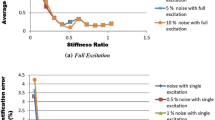Abstract
Rock collapse is a type of fast-moving mass wasting process common in mountainous areas worldwide, and it is hard to predict when collapse will occur. In the experiment, we monitored vibration parameters to predict the time of rock collapse. The results show that the vibration amplitude and fundamental vibration frequency had obvious variations before rock failure, which was consistent with the predicted results of the theoretical model. As the rock became unstable, the vibration amplitude increased by more than 5 times, and the fundamental vibration frequency decreased to less than 41%. Therefore, the monitoring method based on the vibration parameters can record obvious failure precursors for unstable rocks. Our results further develop and refine ambient vibration methods used for implementing the early warning of rock collapse.





Similar content being viewed by others
References
Amitrano D, Grasso JR, Senfaute G (2005) Seismic precursory patterns before a cliff collapse and critical point phenomena. Geophys Res Lett 32(8)
Bottelin P, Jongmans D, Baillet L, Lebourg T, Hantz D, Lévy C et al (2013) Spectral analysis of prone-to-fall rock compartments using ambient vibrations. J Environ Eng Geophys 18(4):205–217
Burjánek J, Gischig V, Moore JR, Fäh D (2017) Ambient vibration characterization and monitoring of a rock slope close to collapse. Geophys J Int 212(1):297–310
Castellini P, Martarelli M, Tomasini, EP (2006) Laser Doppler vibrometry: development of advanced solutions answering to technology’s needs. Mech Syst Signal Process 20(6):1265–1285
Dade WB, Huppert HE (1998) Long-runout rockfalls. Geology 26(9):803–806
Du Y, Xie MW, Jiang YJ, Li B, GAO Y (2015) Methods of determining warning indices based on natural frequency monitoring. Chin Rock Soil Mech 36(8):2284–2290
Du Y, Xie MW, Jiang YJ, Li B, Chicas S (2017a) Experimental rock stability assessment using the frozen–thawing test. Rock Mech Rock Eng 50(4):1049–1053
Du Y, Xie MW, Jiang YJ (2017b) Experimental study on cumulative damage assessment of rock-block using a laser Doppler vibrometer. Chin J Eng 39(1):141–146
Du Y, Xie MW, Jiang YJ (2019) Research progress on dynamic monitoring index for early warning of rock collapse. Chin Eng 41(4):427–435
Got JL, Mourot P, Grangeon J (2010) Pre-failure behaviour of an unstable limestone cliff from displacement and seismic data. Nat Hazards Earth Syst Sci 10(4):819–829
He MC, Miao JL, Feng JL (2010) Rock burst process of limestone and its acoustic emission characteristics under true-triaxial unloading conditions. Int J Rock Mech Min Sci 47(2):286–298
Jaboyedoff M, Dudt JP, Labiouse V (2005) An attempt to refine rockfall hazard zoning based on the kinetic energy, frequency and fragmentation degree. Nat Haz Earth Syst Sci 5(5):621–632
Jia YC, Xie MW, Chang SX (2017) A model for evaluation of stability of sliding- and falling-type dangerous rock blocks based on natural vibration frequency [J]. Rock Soil Mech 38(07):2149–2156
Jia B, Wu Z, Du Y (2019) Real-time stability assessment of unstable rocks based on fundamental natural frequency. Int J Rock Mech Min Sci 124:104134
Johnson BC, Campbell CS, Melosh HJ (2016) The reduction of friction in long runout landslides as an emergent phenomenon. J Geophys Res Earth Surf 121(5):881–889
Kaiser PK, Kim BH (2015) Characterization of strength of intact brittle rock considering confinement-dependent failure processes. Rock Mech Rock Eng 48(1):107–119
Katz O, Reichenbach P, Guzzetti F (2011) Rock fall hazard along the railway corridor to Jerusalem, Israel, in the soreq and refaim valleys. Nat Hazards 56(3):649–665
Lan H, Martin CD, Lim CH (2007) RockFall analyst: a GIS extension for three-dimensional and spatially distributed rockfall hazard modeling. Comput Geosci 33(2):262–279
Lan H, Martin CD, Zhou C, Lim CH (2010) Rockfall hazard analysis using LiDAR and spatial modeling. Geomorphology 118(1–2):213–223
Lato MJ, Diederichs MS, Hutchinson DJ, Harrap R (2012) Evaluating roadside rockmasses for rockfall hazards using LiDAR data: optimizing data collection and processing protocols. Nat Hazards 60(3):831–864
Legros F (2002) The mobility of long-runout landslides. Eng Geol 63(3–4):301–331
Levy C, Jongmans D, Baillet L (2011) Analysis of seismic signals recorded on a prone-to-fall rock column (Vercors massif, French Alps). Geophys J Int 186(1):296–310
Liao Z, Chang JC, Reches ZE (2014) Fault strength evolution during high velocity friction experiments with slip-pulse and constant-velocity loading. Earth Planet Sci Lett 406:93–101
Ma GC, Sawada K, Yashima A, Saito H (2015) Experimental study of the applicability of the remotely positioned laser doppler vibrometer to rock-block stability assessment. Rock Mech Rock Eng 48(2):787–802
Qiu L, Song D, Li Z, Liu B, Liu J (2019) Research on AE and EMR response law of the driving face passing through the fault. Saf Sci 117:184–193
Salawu OS (1997) Detection of structural damage through changes in frequency: a review. Eng Struct 19(9):718–723
Tanaka H, Fujisawa K, Asai K (2008) Identifying unstable rock blocks by measuring micro-tremors and vibration on cliffs. Adv Geosci 14:165–171
Valentin J, Capron A, Jongmans D, Baillet L, Bottelin P, Donze F, Mangeney A (2016) The dynamic response of prone-to-fall columns to ambient vibrations: comparison between measurements and numerical modelling. Geophys J Int 208(2):1058–1076
Yan Y, Li T, Liu J, Wang W, Su Q (2019) Monitoring and early warning method for a rockfall along railways based on vibration signal characteristics. Sci Rep 9(1):6606
Youssef AM, Maerz NH (2012) Development, justification, and verification of a rock fall hazard rating system. Bull Eng Geol Environ 71(1):171–186
Funding
The National Key R&D Program Project of China [grant number 2018YFE0101100], the national natural science foundation of China [grant numbers 41572309, 41702371], and the China post-doctoral science foundation [grant number 2016M591078] provided generous funding for the project.
Author information
Authors and Affiliations
Corresponding author
Ethics declarations
Conflict of interest
The authors declare that they have no conflict of interest.
Rights and permissions
About this article
Cite this article
Du, Y., Lu, Y., Xie, M. et al. A new attempt for early warning of unstable rocks based on vibration parameters. Bull Eng Geol Environ 79, 4363–4368 (2020). https://doi.org/10.1007/s10064-020-01839-2
Received:
Accepted:
Published:
Issue Date:
DOI: https://doi.org/10.1007/s10064-020-01839-2




